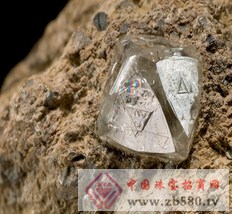
Diamond color
Diamonds come in a variety of colors, from colorless to black, and are colorless. They can be transparent or translucent or opaque. Many diamonds are yellowish, mainly due to impurities in the diamond. Diamond has a very high refractive index and high dispersion properties, which is why diamonds reflect colorful flashes. Diamond emits blue-green fluorescence under X-ray irradiation. Diamond primary ore is produced only in kimberlite rock or a small number of potassium-magnesium lamprophyre. Kimberly rocks and so on are their parent rocks, and diamonds in other places are carried by rivers, glaciers, etc. Diamond is generally granular. If the diamond is heated to 1000 ° C, it will slowly turn into graphite.
China also has the technology to make diamonds, but the maximum is only about 0.2 carats.
Citing the Asian Gemological Association (GIG) report: Diamond has a chemical composition of C, which is a homogeneous polymorphic variant of carbon with graphite. In the mineral chemical composition, it always contains elements such as Si, Mg, Al, Ca, Mn, and Ni, and often contains impurity elements such as Na, B, Cu, Fe, Co, Cr, Ti, and N, and carbohydrates.
The diamond mineral crystal structure is an equiaxed crystal system with a homopolar tetrahedral structure. The carbon atoms are located at the top and center of the tetrahedron and have a high degree of symmetry. The carbon atoms in the unit cell are connected by the same-pole bond at a distance of 154 pm. Common crystal forms include octahedron, rhombohedral dodecahedron, cube, tetrahedron and hexahedron.
The absolute hardness of diamond is 4 times that of corundum and 8 times that of quartz. The detailed absolute hardness is as follows:
Diamond 10000-2500
Corundum 2500-2100
Quartz 1550-1200.
Mineral brittle, shell-like or staggered fracture, cracking along the crystal cleavage plane under small impact, medium or complete cleavage with parallel octahedron, incomplete cleavage of parallel dodecahedron. The minerals are pure and the density is generally 3470-3560kg/m3. The color of diamond depends on the degree of purity, the type and content of the impurity elements contained in it, and it is extremely pure and colorless. Generally, it is yellow, brown, gray, green, blue, milky white and purple, etc.; pure is transparent and contains impurities. Translucent or opaque; under cathode ray, X-ray and ultraviolet light, it will emit different colors of green, sky blue, purple, yellow-green, etc.; after sun exposure, it will light blue-green phosphorescence in the dark room; diamond gloss, a few Grease or metallic luster, high refractive index, generally 2.40-2.48.
Diamond stability
Diamond is chemically stable, resistant to acid and alkali, does not interact with concentrated HF, HCl, HNO3 at high temperatures, only in the melt of Na2CO3, NaNO3, KNO3, or when boiled with a mixture of K2Cr2O7 and H2SO4. Slightly oxidized; corroded in high temperature gases of O, CO, CO2, H, Cl, H2O, CH4.
Diamond also has non-magnetic properties, poor electrical conductivity, lipophilic hydrophobicity, and triboelectricity. Only Type IIb diamond has good semiconductor properties. According to the difference of nitrogen impurity content and thermal, electrical and optical properties of diamond, diamond can be divided into two types, I type and II type, and further subdivided into four subtypes of Ia, Ib, IIa and IIb. Type I diamonds, especially the Ia subtype, are common common diamonds, accounting for about 98% of the total natural diamond. Type I diamonds contain a certain amount of nitrogen, which has good thermal conductivity, poor electrical conductivity and good crystal form. Type II diamonds are extremely rare, contain little or no nitrogen, and have good thermal conductivity and curved crystal characteristics. Type IIb subtype diamond is semiconducting. Due to its excellent performance, Type II diamonds are used in space technology and cutting-edge industries.
The world's largest industrial diamond and gem-quality diamonds exceed 3,100 carats (1 carat = 200 mg). The size of the gem-quality diamond is 10 × 6.5 × 5 cm, called "Cullinan", and was discovered in South Africa in 1905. China Changlin Diamond, weighing 158.786 carats, was discovered in 1977 by Wei Zhenfang, a female member of the Linlin County, Shandong Province, and later listed as a world famous diamond. The world's major diamond producers are South Africa, Australia, Zaire, Botswana and Russia.
This kind of Functional Fabric is usually produced by special material,like aramid, FR viscose,modacrylic,hygroscopicity and quick drying yarn,etc. The special functions usually include flame retardant,waterproof,oil proof,anti-static,anti-mosquito,hygroscopicity and quick drying,easy-care,antibacterial,anti-UV,infrared retardant,etc.
Raw Fabric Material,Raw Cotton Material,Raw Material Uniform Fabric,Raw Material Military Fabric
Zhejiang Xinjian Textile Inc.Ltd , https://www.zjxjtex.com